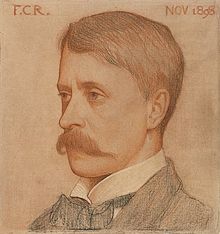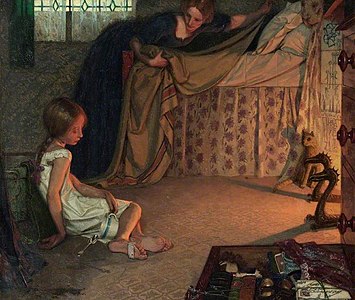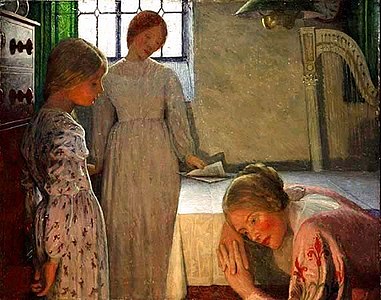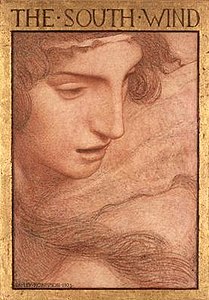Frederick Cayley Robinson
This article includes a list of general references, but it lacks sufficient corresponding inline citations. (January 2023) |

Frederick Cayley Robinson ARA (18 August 1862 – 4 January 1927) was an English artist who created paintings and applied art, including book illustrations and theatre set designs. Cayley Robinson continued to paint striking Pre-Raphaelite and Victorian subjects well into the twentieth century despite this approach becoming deeply unfashionable.
His series of large-scale mural paintings for the Middlesex Hospital entitled Acts of Mercy commissioned around 1915 and completed in 1920 are some of his most impressive works, along with Pastoral (1923; Tate Britain, London), which was bought by the Chantrey Bequest for the nation. However his many smaller paintings, particularly of interiors featuring sombre women as well as the theme of departure, are significant works of modern British art.
Biography
[edit]

Born on 18 August 1862, in Brentford-on-Thames, Middlesex, Frederick Cayley Robinson was the son of Frederic Robinson, an engineer. He was educated at the East Cliff House school run by Dr. Frederick George Head, in Cliftonville, and in France at the Lycée de Pau.[1][2] He studied at the St. John's Wood Art School, London, and from 1885 to 1888 at the Royal Academy Schools. Early on, Cayley Robinson painted scenes of the sea in the fashionable Newlyn style, and from 1889 to 1891 he sailed in a boat around Britain.
When he returned, Cayley Robinson studied at the Académie Julian in Paris from 1891 to 1894. The artist's time studying at the académie had a critical influence on his entire artistic output, which displays the influence of European Symbolism, especially the avant-garde group the Nabis and the revival of interest in Edward Burne-Jones in Paris at this time. Like many of his peers, Cayley Robinson felt drawn to a new style of art, moving away from modern impressionism and appearing to emulate the visionary medievalism of the Pre-Raphaelites.
Various connections — for example with the Glasgow School of Art, and within the circle of Charles Ricketts and Charles Shannon — brought Cayley Robinson closer to the occult revival of the period, including the Golden Dawn and esotericism. This context also infused his artworks. From the late 1890s, Cayley Robinson developed his own distinctive oeuvre of artistic expression which combined simple, quiet domesticity – the everyday - with hints of the occult, the mysterious, and the wondrous.
From 1898 to 1901, like many artists of the period, Cayley Robinson visited Florence and during that time studied the Old Masters and techniques such as tempera. In 1904, he became a founder member of the Society of Painters in Tempera. This brought him in contact with a number of other like-minded artists, notably Mary Sargant Florence and Lady Christiana Herringham, both of whom were involved with the suffrage movement.
A central theme of Cayley Robinson's paintings was enchantment. He produced very popular illustrations and set designs for the Haymarket Theatre production in London of Maurice Maeterlinck's The Blue Bird in 1910. In the period 1907-1914, Cayley Robinson was connected with the London based Art Theosophical Circle, a group which sought forms of artistic enchantment in the modern world. The artist contributed illustrations for their published journal Orpheus.
In 1914, Cayley Robinson moved with his family into 1 Lansdowne House, Lansdowne Road, Kensington, London. This was a custom-built studio apartment block inhabited solely by artists. In the same year, the artist took up his only teaching professorship, at the Glasgow School of Art, which he held for ten years.
Frederick Cayley Robinson died of influenza on 4 January 1927 in a nursing home at 1 Ladbroke Square, Kensington; he was survived by his wife.
The Outward Bound
[edit]Cayley Robinson painted two works named The Outward Bound. His 1903 work shows a young man in a small boat in a harbour watching as a large sailing ship is towed out to sea by a tug. The 1912 work has the same composition, but the departing ship is a four-funnelled liner, identified as the Titanic which sank on its maiden voyage in that year.[3][4] This version was given to Leeds City Art Gallery by the Leeds Professional Musicians, in memory of Wallace Hartley, the violinist from Dewsbury who led the orchestra on the Titanic and died when it sank.[5] The painting was unveiled in the City Art Gallery by the Lord Mayor of Leeds on 23 December 1912.[5] The 1903 work is in gouache and pencil and measures 30.5 cm × 39 cm (12.0 in × 15.4 in)[3] while the 1912 work is an oil painting of 71.1 cm × 91.4 cm (28.0 in × 36.0 in).[4]
Exhibitions
[edit]During his lifetime, Cayley Robinson regularly exhibited at the Royal Academy and the Society of British Painters and held several important solo shows.
Whilst neglected for much of the twentieth century, there has been an increase in the exhibition of Cayley Robinson's work in the twenty-first century:
2006-7: Chasing Happiness at the Fitzwilliam Museum, Cambridge, which displayed his illustrations for Maurice Maeterlinck's The Blue Bird
2010: the National Gallery displayed six works by Cayley Robinson including the four panels of the Acts of Mercy mural series, which had been rescued and purchased by the Wellcome Trust in 2007
2022-23: Many of Cayley Robinson's artworks featured in the exhibition Modern Pre-Raphaelite Visionaries: British Art, 1880-1930 at the Leamington Spa Art Gallery, 13 May - 18 September 2022 and the Watts Gallery, Compton from October 2022- February 2023). A publication entitled Modern Pre-Raphaelite Visionaries: British Art, 1880-1930 was produced to coincide with the exhibition.
Family
[edit]Cayley Robinson married in 1898 the painter Winifred Lucy Dalley, daughter of the stockbroker John Lambert Dalley. They had one daughter.[1]
Notes
[edit]- ^ a b Reynolds, Simon. "Robinson, Frederick Arthur Cayley (1862–1927)". Oxford Dictionary of National Biography (online ed.). Oxford University Press. doi:10.1093/ref:odnb/59235. (Subscription or UK public library membership required.)
- ^ Carteret-Bisson, Frederick Shirley Dumaresq de (1884). Our Schools and Colleges. Simpkin, Marshall. p. 946.
- ^ a b "Bonhams : Frederic Cayley Robinson, ARA, RWS (British, 1862-1927) The outward bound". www.bonhams.com. Bonhams. 30 March 2022. Retrieved 6 May 2024.
- ^ a b The Outward Bound (Art UK)
- ^ a b "Wallace Hartley: One of the musicians who 'played on' as the Titanic sank". Catablogue. West Yorkshire Archive Service. 27 April 2012. Retrieved 6 May 2024.
Further reading
[edit]- Munro, Jane (2006). Chasing Happiness: Maurice Maeterlinck, The Blue Bird and England. Fitzwilliam Museum Enterprises, Cambridge. ISBN 978-0904454758.
- Turner, Sarah Victoria (2009). 'Spiritual Rhythm' and 'Material Things': Art, Cultural Networks and Modernity in Britain, c. 1900-1914. Unpublished PhD Thesis, The Courtauld Institute of Art (University of London).
- Eden, Alice (2016). Women, Representation and the Spiritual in the Works of Thomas Cooper Gotch, Robert Anning Bell and Frederick Cayley Robinson (PDF). Unpublished PhD thesis, University of Warwick.
- Eden, Alice, ed. (2022). Modern Pre-Raphaelite Visionaries: British Art 1880-1930. Leamington: Warwick District Council and the Paul Mellon Centre for Studies in British Art.
- Eden, Alice (2024). Spirituality, Feminism, Pre-Raphaelitism in Modern British Art and Culture. London and New York: Routledge.
Gallery
[edit]- Works by Frederick Cayley Robinson
-
The Foundling, 1896, Leamington Spa Art Gallery
-
The Blue Bird Dreamships, 1900, Leamington Spa Art Gallery
-
Men, women, and children at a picnic in the park (detail), 1900
-
The Call of the Sea, c. 1900
-
A Winter Evening, c. 1900
-
The South Wind, 1903
-
Orphan girls entering the refectory of a hospital, 1915, Wellcome Collection
-
Orphan girls in the refectory of a hospital, proceeding to their place at the table, c. 1915, Wellcome Collection
-
The doctor, 1916, Wellcome Collection
-
The Outward Bound, 1903
-
The Outward Bound, 1912, Leeds Art Gallery
-
Wounded and sick men gathered outside a hospital, 1920, Wellcome Collection
-
The Word, c. 1922
-
Tyltyl Turns the Diamond, illustration from The Blue Bird, by Maurice Maeterlinck (48th ed. 1923)
-
Youth, 1923, private collection
-
British Industries, 1923, Pinacoteca Nazionale (Siena)
-
Pastoral, 1923-24, Tate Britain
External links
[edit]- 24 artworks by or after Frederick Cayley Robinson at the Art UK site
- National Gallery exhibition 2010 Archived 14 February 2017 at the Wayback Machine
- Review of the 2010 Tate exhibition Evening Standard
- Review of the 2010 Tate exhibition The Guardian
- Slideshow of the 'Acts of Mercy' The Guardian
- Wellcome Collection Library Catalogue
- 19th-century English painters
- English male painters
- 20th-century English painters
- British modern painters
- 1927 deaths
- 1862 births
- Deaths from influenza in the United Kingdom
- People from Brentford
- Associates of the Royal Academy
- Alumni of the Royal Academy Schools
- 20th-century English male artists
- 19th-century English male artists

















